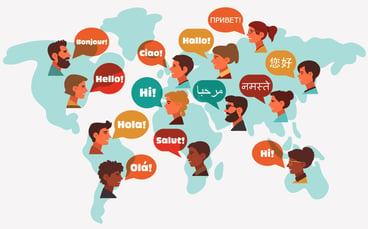Posted by Caveo Learning ● July 14, 2020
Read These 10 Tips Before Translating Your Learning
 The process of translating learning materials is a critical step for a global organization to effectively function as a cohesive unit. With new markets come new employees who may require translation into their native language. This is a complicated endeavor requiring expertise around localization, technology, and cultural differences. Thoughtful planning will save you time and money, and will help avoid setbacks down the line.
The process of translating learning materials is a critical step for a global organization to effectively function as a cohesive unit. With new markets come new employees who may require translation into their native language. This is a complicated endeavor requiring expertise around localization, technology, and cultural differences. Thoughtful planning will save you time and money, and will help avoid setbacks down the line.
Here are 10 tips to make learning translation and localization an easier effort.
- Kick off with translation in mind. During the project kickoff, an agenda item should be added to the meeting to discuss locales and what translation services are required. Knowing this information guides content decisions. Also, any project requiring translation usually means the English is developed for ESL speakers.
- Determine your target languages. Commonly spoken languages differ by country/region and require a separate translation effort. For example, European Spanish differs from Latin American Spanish and European Portuguese differs from Brazilian Portuguese. Both these examples will require unique translations and voice-over artists.
- Keep language simple and direct. This helps not only with the comprehension post-translation, but also reduces the overall cost by limiting excessive content—Be precise, logical, and literal. Even the shortest content written in English can easily double or triple when translated. A common metric for text expansion from source to targeted language is 30%.
- Pay attention to design elements. Keeping this in mind when making layout decisions will prevent rework during course development of the translated courses. Compensate by maintaining flexible design components and additional space for screen text and graphics. Keep the text on the page and out of graphical elements.
- Translate your company speak. Customize your digital libraries and translation glossaries with jargon and other words that are unique to your company or industry, and identify their analogs in other languages. This will allow you to ensure the words are translated and localized correctly every time, without incurring additional cost or review cycles.
- Don’t get “lost in translation.” Puns, slang, humor, metaphors, and pop culture references can be useful tools to appeal to an audience or illustrate an example, but they often fail to make much sense to those without the proper cultural context. Be careful—humor rarely translates well—what is funny and compelling in one culture can be offensive or confusing in another.
- Use “real people” for QA. It’s tempting to cut corners by using machines to do the translating, but they are error prone, unnatural, and can miss the context of the message. Machine translations do not understand the nuances of language. An important quality step is to ensure that an in-country QA resource reviews the text and flow prior to development of the translated course.
- Weigh voiceovers vs. subtitles. One of the most important decisions during the learning translation process is whether to go with subtitles or voiceovers. While subtitles may be more cost efficient, voiceovers may be more effective. Try to leverage more animations and graphical representations instead of a talking head. This will allow you to easily translate, align the audio to the on-screen action, and will be less distracting to the learner.
- Double check for timing. This is the secret to ensuring an easier integration of translated audio or text into your eLearning module. Time the translated text to sync up with the initial version of the multimedia. To do this, create a script that includes transitions, so that you can identify timestamps for the translated audio or text.
- Stay organized. Ask your translators for a list of country codes and use those codes for file naming of translated files and images. Keep source files labeled and within identical hierarchical structures across all languages, ensuring that the in-country localization workers are using the most up-to-date materials.
Bonus tip: Use native speakers for voiceover recording. This will ensure that your voiceover talent speaks with the same accent and uses the same dialect as your learning audience. Keep in mind that native speakers might pronounce non-translated English terms incorrectly—terms that remain in English such as acronyms, brand names, and cities, should be closely reviewed to ensure proper pronunciation.
Preparing for the translation and localization process from the very start of the project can save setbacks in the later phases of the project. Whether you work with a professional translation company, an in-house resource, or freelance translators, keep these best practices in mind to ensure your learning deliverables are easily localized and optimized, no matter where your audience is located.
Topics: Instructional Design, Global Learning

